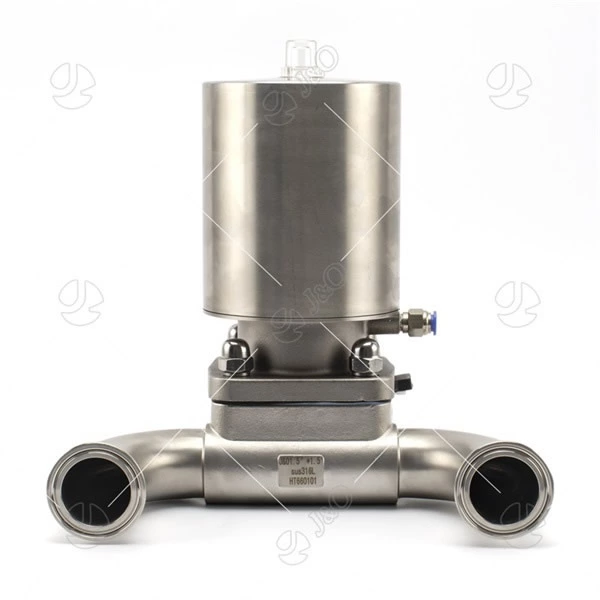Common Failures And Preventive Measures Of Sanitary Diaphragm Valves
Sanitary Diaphragm Valve Fault phenomenon:
(1) Leakage on the valve cover sealing surface. The diaphragm valve head is composed of upper and lower valve covers and diaphragms fastened with bolts. The chamber between the upper valve cover and the diaphragm introduces the emergency shut-off oil of the main engine lubricating oil system. This sealing surface has been leaking since the unit was put into production, and the effect of multiple treatments has not been good.
(2) The diaphragm ruptures and causes the oil pressure to disappear, and the diaphragm valve opens. The diaphragm of the diaphragm valve ruptures, and the lubricating oil flows to the high-temperature pipeline, so the machine has to be shut down and replaced with a new diaphragm. After inspection, it was found that there was a 3 mm diameter perforation at the contact point between the diaphragm and the spring tray.
Cause analysis of sanitary diaphragm valve:
(1) The adjustment gate (for pressure relief) for adjusting the oil pressure is a needle valve. Due to the influence of factors such as vibration, it will gradually close during operation, causing the oil pressure to rise slowly. If the adjustment is not timely, the diaphragm will operate under an overpressure of 0.80-0.85 MPa, which accelerates the damage of the diaphragm. In addition, when the main engine was conducting an overspeed test, the speed increased to about 3,300 r/min. Due to untimely adjustment, the oil pressure of the diaphragm valve once increased to 0.9 MPa, causing short-term overpressure.
(2) The design width of the upper and lower valve cover sealing surfaces is too small. Inspection found that the sealing width (extrusion deformation part) of the leaking diaphragm is less than 5 mm as a whole.
(3) The thickness of the upper and lower valve cover plates is only 5 mm. According to the calculation of the upper valve cover diameter of 240 mm and the oil pressure of 0.8 MPa, the pressure is about 36,170 N. The valve cover plate is deformed by force, and the sealing plane of the upper and lower valve covers has an inward opening, which further narrows the sealing surface and aggravates the leakage.
(4) The diaphragm installation process is unreasonable. The maintenance personnel are not familiar with the structural principle of the diaphragm valve. When installing the new diaphragm, they did not take measures to loosen the adjustment nut to make the spring lose its force, but carried out it with the diaphragm valve open. Because the spring tray is in a high position, the diaphragm is in contact with the upper valve cover, but there is a gap of 20 mm with the lower valve cover. In order to fasten the three together, a long-rod bolt is used to force the connection (the purpose is to overcome the elastic force of the spring). At this time, the bolt hole of the diaphragm is pulled and deformed, which is easy to cause damage. In addition, the position of the bolt hole is offset inward relative to the bolt hole of the valve cover and becomes elliptical, the sealing surface becomes narrower, and the sealing effect becomes worse.
(5) There are bubbles in the gel part of the diaphragm, and there is a stratification phenomenon inside. The maintenance personnel did not check carefully before replacement and failed to discover it in time, leaving hidden dangers of failure after installation.
(6) Accidental damage to the diaphragm. The diaphragm is not properly protected during storage and installation. The diaphragm contacts corrosive liquids or collides and squeezes with the sharp parts of tools and parts (such as raised corners of the spring tray), which damages and scratches the surface of the diaphragm. Failure to deal with it in time causes leakage hazards.
Aseptic sanitary diaphragm valve
Preventive measures for sanitary diaphragm valves:
(1) Carefully inspect the goods to prevent the use of unqualified products. The diaphragm should be properly stored and preserved; during the installation process, care should be taken not to allow the diaphragm to be hit or scratched; pay attention to check the upper valve cover and spring tray, clean the burrs, and keep the contact parts smooth. After the above treatment, the diaphragm valve operates well, ensuring the long-term normal operation of the main equipment.
(2) Prevent the diaphragm from operating under overpressure. The operating personnel should strengthen monitoring and immediately notify the maintenance personnel to calibrate the pressure gauge if the oil pressure exceeds the standard. After confirming that the oil pressure has increased, the adjustment door should be slowly turned to stabilize the pressure within the rated range. In particular, during the unit speed increase and main engine overspeed test, a special person should be assigned to monitor the oil pressure on site and adjust it in time.
(3) Modify the upper and lower valve covers. After demonstration and experiment, while keeping the control oil system safety oil pressure unchanged and not affecting the characteristics of the diaphragm valve, the valve cover is newly processed in the form of the original parts, the thickness is increased to 10 mm, and the sealing surface width is expanded inward to 10 mm. This measure was implemented on units 1 and 2 in 2003 and 2004 respectively, with good results and no leakage has occurred so far.
(4) Improve the diaphragm installation process. Before replacing the diaphragm, first measure and record the exposed size of the adjustment nut, and screw it downward to make the spring free and the spring tray in the low position. At this time, when installing the diaphragm, there is no gap and the bolts can be tightened symmetrically and evenly. After installation, screw the adjustment nut upward to its original position.
